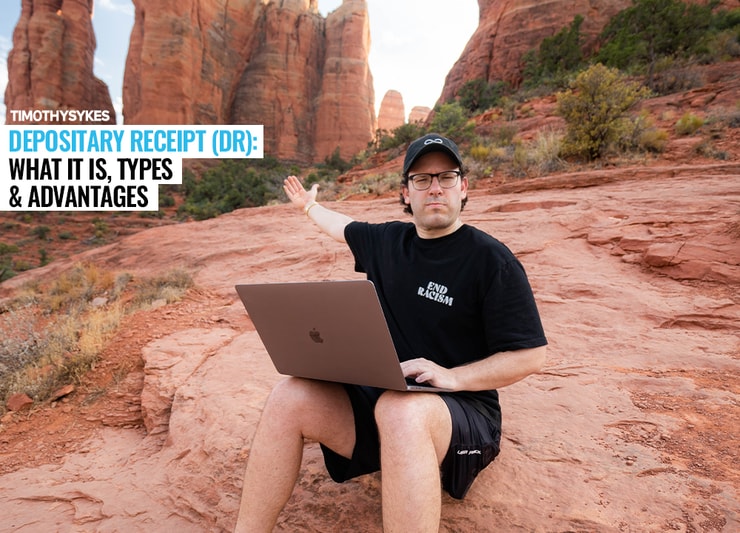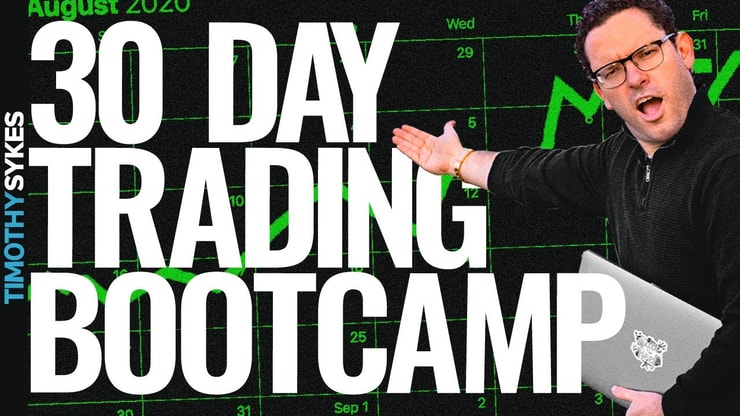What the heck is a depository receipt? Good question … It’s not very different from ordinary shares.
They can even present exciting new trading or investing opportunities…
Like all trading and investing, they come with risks. But once you understand them, you can potentially use them to your advantage.
In this post, I’ll discuss ADRs, depositary receipt types (like sponsored depositary receipts), and some advantages of depositary receipts.
Let’s do this!
Table of Contents
What’s a Depositary Receipt?
A depository receipt (DR) is a transferable certificate that represents shares of a foreign company.
It’s a way to own shares of a foreign company without having to trade on a foreign market or deal with foreign currency.
They used to be an actual paper certificate, similar to a contract. Now they’re traded on the major exchanges or OTC markets, just like regular shares.
New to penny stocks? Get my FREE online guide here and study up!
How Does a Depositary Receipt Work?
If a company wants to be listed on a U.S. exchange, it must meet the requirements of the exchange where it wants to list.
It has to be a publicly traded company in its country of origin or it has to go through the process of an initial public offering (IPO).
DRs can be issued on the major exchanges or on the OTC markets. I’ll get into how that’s determined later…
The issuing of DRs works like this…
A brokerage house, located in the same country as the issuing company, purchases stock of the company from the exchange. The brokerage house then transfers the shares to a custodial bank to hold the shares.
The bank acts as an agent between the two countries to make sure the shares exist and there’s no fraud.
The shares are then delivered to a U.S. bank. (Or whichever country will be selling the DRs.) The shares are then packaged up as DRs.
One DR can represent a partial, one, or multiple shares of the original company. The U.S. bank determines the price of the DRs based on the exchange rate and the price at which the company trades in its country of origin.
Ready to build your market know-how? Get “The Complete Penny Stock Course” by my student Jamil. He compiled all my core penny stock trading lessons into one book. It deserves a spot on every day trader’s desk.
(Psst … get the book for free when you get into the 30-Day Bootcamp my top student Matthew Monaco helped me put together. It’s a steal at less than $100!)
Types of Depositary Receipts
There are different depositary receipt types, depending on the country issuing the foreign stock … Let’s get into it!
American Depositary Receipts (ADRs)
American Depositary Receipts are available to U.S. investors on all three of the major U.S. exchanges or on the OTC markets. It’s how American investors purchase foreign companies on local exchanges.
They’re the most common type of depositary receipt. They’ve been available to American investors since the 1920s.
An ADR is either sponsored or unsponsored…
Sponsored ADR
Sponsored depositary receipts have different levels of sponsorship — levels one, two, and three. There are also restricted programs, but I won’t get into those because they’re not publicly traded.
Level 1 is the lowest level and it’s also the most popular. These require the least amount of reporting by the company and results in the ADRs trading on the OTC markets.
A level 2 ADR requires the company to meet more Securities and Exchange Commission (SEC) disclosure requirements. (If you want to learn how to read these complicated documents, get my DVD, “Read SEC Filings.”)
If the company meets the requirement and files the required forms regularly, it can be listed on any of the major exchanges.
A level 3 ADR is the highest level. The company has to meet strict requirements, the same as American listed companies. This is because companies that set up a level 3 program can issue new shares into U.S. markets, in addition to its DRs.
Non-Sponsored ADR
Unsponsored ADRs are listed on the OTC markets. They’re shares that are issued without the company having an agreement with a depositary bank. Unsponsored DRs can be issued by multiple banks based on market demand.
These are pretty shady to buy or trade because the company has no knowledge or interest in the company’s shares being sold in a different market. Holders of unsponsored ADRs also have no voting rights.
When ADRs are sponsored, at least the company is doing it to improve the company’s exposure, and it’s willing to provide at least minimal information about the company.
Personally, I never trust penny stock companies. Expect the worst and you’ll never be disappointed … And if you’re going to trade them, focus on your education first.
European Depositary Receipts (EDRs)
European depositary shares are the opposite of American depositary shares. They’re shares of American companies that want access to foreign markets, like the London Stock Exchange.
The American company would enter a depositary receipt agreement with a London bank. The bank would then sell the company’s shares on the London Stock Exchange and convert the price from U.S. dollars to euros.
Global Depositary Receipts (GDRs)
A global depositary receipt is similar to an ADR or EDR but it’s a broader term.
A company can choose to issue its shares to multiple countries. It’s not restricted to only selling in one foreign country. If the company wants money raised from the sale of shares in Euros then it’s called an EDR.
What Are the Advantages of Depositary Receipts
Depository receipts are cheaper and more convenient than trading in foreign markets. There’s no need for foreign currency or having to deal with exchange rates.
They also allow investors to diversify their portfolios. It gives investors access to companies in different markets and economies. They’re traded in U.S. dollars and trade the same as ordinary shares would.
They’re also great for the company issuing them. It gives them exposure to global markets and a bigger pool of investors.
As a trader, they can open up more opportunities. The stocks will still move based on news and economic changes in the company’s home country. So you might find an edge there…
I trade anywhere there’s an opportunity. Don’t limit yourself to a small number of stocks. Be willing to try new things until you find your niche.
A lot of people don’t want to trade OTC stocks because they’re so sketchy. That’s exactly why I like them. Because the big Wall Street players don’t trade them. I don’t have to compete against hedge funds and algorithms.
I think they have cleaner charts and aren’t as choppy as stocks on the major exchanges. That’s why I think they’re so great for beginners with small accounts.
You have to find what works for you and trade whatever fits your patterns and strategy.
The Disadvantages of Depositary Receipts

Some disadvantages of depositary receipts for a trader are the possibilities of exchange fees on dividends or having to pay double taxes.
Investors can also be exposed to any economic booms or busts in the foreign company. You might need to do some extra research on the country before buying in. Make sure the country is economically and politically stable.
Depositary receipts are only available for a limited number of companies. You won’t have access to all foreign companies.
Also, beware of the lower level sponsored ADRs and unsponsored ADRs that can be a bit riskier.
Since I don’t invest and hold stocks long term, that doesn’t really apply to me. I’m used to trading sketchy OTC stocks. That’s why I’m in and out of stocks fast. I don’t want to be exposed to risk for too long and I always cut losses quickly!
If you want to learn how I trade penny stocks, start with my no-cost penny stock guide. Then, get in my 30-Day Bootcamp.
It’s a month’s worth of lessons with daily assignments and homework. You can work at your own pace and repeat it as often as you like. Bonus: It comes with “The Complete Penny Stock Course” book and my “Pennystocking Framework” DVD.
Depositary Receipts vs. Common Stock
Depositary shares represent shares in a foreign company, so how do they differ from owning common stock of the company?
There isn’t much of a difference. Once the DRs are trading on the local exchange, they’re treated and traded just like regular shares would be.
In some instances, as part of an IPO, a company might make DRs convertible into common stock. But for the most part, they remain separate.
Should You Buy Depositary Receipts?

If you’re into investing, DRs can potentially be a good way to access foreign companies. It can open you up to new opportunities.
That said, I don’t invest — I day trade.
I get in and out of stocks quickly. And I trade anything that fits my strategy and patterns. I like stocks with a big percent gain for the day, a catalyst, and high volume.
If a DR matched my criteria, I’d probably trade it. I trade all kinds of sketchy companies on the OTC markets.
For me, it’s all about sticking to my rules, minimizing my risk by cutting losses quickly, and never believing any of the hype about a company. I did that once and lost $500,000 of my own money.
Read about my loss in my book, “An American Hedge Fund.” (Get a no-cost downloadable version here.)
Now I don’t trust any of them. I trade the ticker and the price action, not the company. Then I move on to the next opportunity.
Conclusion
Whether you trade or invest, there are always risks. DRs are no exception. And with all the market volatility we’ve seen this year, there’s no way to know which way the markets will go from day to day.
That’s why it’s important to trade or invest with rules. These are my rules.
If you have the discipline and dedication to your education, apply for my Trading Challenge.
You’ll get access to all my DVDs, video lessons, weekly live trading and Q&A webinars with me and my top students, and my Challenge chat room.
I wish I’d a mentor when I was learning. Instead, I had to learn the hard way — from my own mistakes. That’s why it’s my honor to teach now so I can be the mentor to you that I never had.
Start learning what it takes to be successful in any market, apply today!
Have you traded depositary receipts? Let me know in the comments … I love to hear from my readers!







Leave a reply